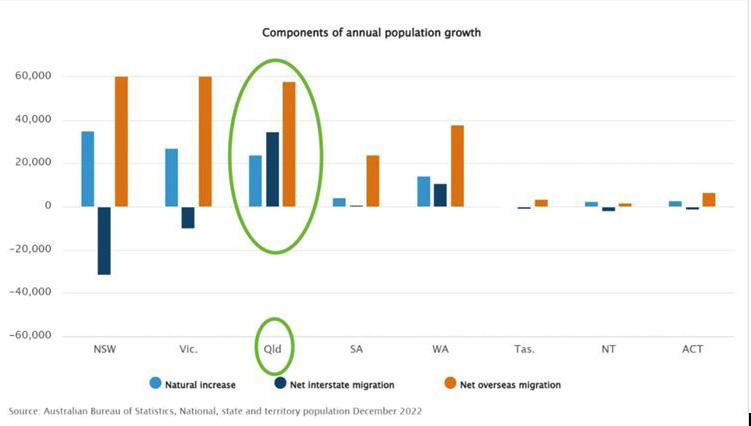
3 minute read
Queensland added 320 people a day in 2022!
According to the Australian Bureau of Statistics, Australia experienced a net migration of 496,800 people as of December 2022. This translates to an average of 1,361 people arriving in the country every day. Here are some interesting numbers:
Australia’s population was 26,268,359 people at 31 December 2022.
Advertisement
The quarterly growth was 127,078 people (0.5%).
The annual growth was 496,800 people (1.9%).
Annual natural increase was 109,800 and net overseas migration was 387,000.
The reopening of international borders and the return of international students are expected to contribute to the continued influx of migrants. This significant population growth is particularly prominent in Queensland, making it an attractive destination for both domestic and international investors.
Queensland has consistently experienced the largest population growth in Australia, and this trend shows no signs of slowing down. The continuous increase in population will have a profound impact on the housing market. As the demand for housing surpasses supply, property prices and rents will naturally rise. Investing in Queensland now means getting ahead of the curve and taking advantage of the future market conditions, which are poised to favour property owners.
Moreover, despite the talk of an impending recession and 12 interest rate increases, reputable property research houses and banks unanimously agree that the housing market bottom was reached early this year. This means that the market has already gone through a correction phase and is now on an upward trajectory. Seizing the opportunity to enter the market at the beginning of a new property cycle is rare and can potentially yield significant returns on investment. While attempting to time the market perfectly is not advisable, it is an opportunity that most investors dream of. The current conditions in Queensland's real estate market align with the factors that make investing attractive: population growth, increasing demand for housing, and a market that has already bottomed out. By taking action now, you position yourself to benefit from the anticipated growth and appreciation in property values.
In conclusion, the current statistics and trends in Queensland indicate that now is the ideal time to invest in the state's real estate market. The continuous population growth, tightening housing supply-demand equation, and the confirmation from industry experts that the market has already bottomed out all point towards a favorable investment climate.
Are you eager to initiate the research process and embark on the path towards your investment or dream home in South East Queensland? Take the opportunity to connect with Anna Khandhar today for an informative discussion on how she can provide valuable assistance in turning your real estate aspirations into tangible achievements. You can easily reach Anna at 0424 164 980 or via email at anna@lyrahomes.com. au. Don't hesitate to take this important step towards realizing your property goals.




New York, July 11 (IANS) A team of Indian-origin researchers has developed a real-time monitor that can detect any of the SARSCoV-2 virus variants in a room in about five minutes.
The inexpensive, proof-ofconcept device, developed by combining recent advances in aerosol sampling technology and an ultrasensitive biosensing technique, could also potentially monitor for other respiratory virus aerosols, such as influenza and respiratory syncytial virus (RSV).
It can be used in hospitals and health care facilities, schools and public places to help detect the viruses.
“There is nothing at the moment that tells us how safe a room is,” said John Cirrito, a professor of neurology at the School of Medicine at Washington University in St. Louis.
“If you are in a room with 100 people, you don’t want to find out five days later whether you could be sick or not. The idea with this device is that you can know essentially in real time, or every 5 minutes, if there is a live virus,” he added. Published in the journal Nature Communications, the researchers called it the most sensitive detector available.
Cirrito along with Rajan Chakrabarty, Associate Professor at the varsity’s McKelvey
School of Engineering and Joseph Puthussery, a postdoctoral research associate in Chakrabarty’s developed the detector by converting a biosensor that detects amyloid beta as a biomarker for Alzheimer’s disease.
Chakrabarty and Puthussery exchanged the antibody that recognises amyloid beta for a nanobody from llamas that recognise the spike protein from the SARS-CoV-2 virus.
The team developed the nanobody that is small, easy to reproduce and modify and inexpensive to make. They integrated the biosensor into an air sampler that operates based on the wet cyclone technology. Air enters the sampler at very high velocities and gets mixed centrifugally with the fluid that lines the walls of the sampler to create a surface vortex, thereby trapping the virus aerosols.
The wet cyclone sampler has an automated pump that collects the fluid and sends it to the biosensor for seamless detection of the virus using electrochemistry.
“The challenge with airborne aerosol detectors is that the level of virus in the indoor air is so diluted that it even pushes toward the limit of detection of polymerase chain reaction (PCR) and is like finding a needle in a haystack,” Chakrabarty said.
“The high virus recovery by the wet cyclone can be attributed to its extremely high flow rate, which allows it to sample a larger volume of air over a 5-minute sample collection compared with commercially available samplers.”

Most commercial bioaerosol samplers operate at relatively low flow rates, Puthussery said, while the team’s monitor has a flow rate of about 1,000 litres per minute, making it one of the highest flowrate devices available.
It is also compact at about 1 foot wide and 10 inches tall and lights up when a virus is detected, alerting administrators to increase airflow or circulation in the room.










